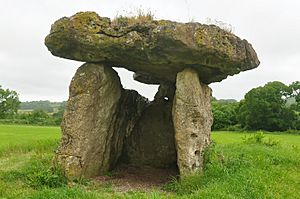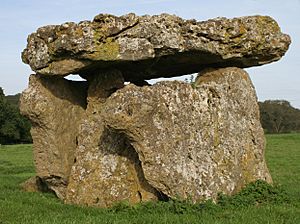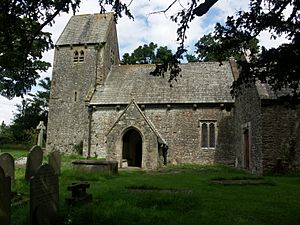St Lythans burial chamber facts for kids
|
Welsh: Siambr Gladdu Llwyneliddon
|
|
 |
|
| Location | near St Lythans and Barry (Y Barri) |
|---|---|
| Region | Vale of Glamorgan (Welsh: Bro Morgannwg), Wales (Welsh: Cymru) |
| Coordinates | 51°26′33.11″N 3°17′41.68″W / 51.4425306°N 3.2949111°W |
| Type | Dolmen |
| History | |
| Periods | Neolithic |
| Site notes | |
| Condition | some damage |
The St Lythans burial chamber (Welsh: Siambr Gladdu Llwyneliddon) is a very old stone tomb. It is a type of structure called a dolmen. People built it around 4,000 BC. This was during the middle of the Neolithic period, also known as the New Stone Age. It was part of a larger burial mound in what is now the Vale of Glamorgan, Wales.
You can find this ancient site about 1 kilometer west of the small village of St Lythans. It is also close to Dyffryn Gardens. Another similar, but larger, stone tomb called Tinkinswood burial chamber is about 1.6 kilometers south. St Lythans might have looked like Tinkinswood a long time ago.
The site is on grassy land where cows sometimes graze. You can visit it for free. There is space for a few cars to park about 50 meters away.
Cadw, which is the Welsh Historic Environment Agency, takes care of the dolmen. This site has never been fully dug up by archaeologists.
Contents
Where is St Lythans Burial Chamber?
The burial chamber stands in a field called Maesyfelin, which means "The Mill Field." This field is south of St Lythans Road. Cadw helps maintain the roadside parking area.
You can enter the field through a special gate called a kissing gate. The field gently slopes down towards the northwest. It is free to visit. Wheelchairs cannot access the site, but you can see it clearly from the gate, about 50 meters away.
What Does It Look Like?
This ancient tomb is a dolmen, a common type of large stone structure in Europe. It sits at the eastern end of a flat-topped mound. This mound is about 27 meters long and 11 meters wide. It forms part of a chambered long barrow, which is a long burial mound.
The St Lythans chamber is part of the Severn-Cotswold type of tombs. It has three tall, upright stones, called orthostats. These stones hold up a very large, flat stone on top, called a capstone. All the stones are made of mudstone. These stones were likely found nearby, just like the ones used at Tinkinswood.
The capstone is about 4 meters long and 3 meters wide. It is about 0.7 meters thick. It slopes down from the southeast to the northwest. The inside surfaces of the two front upright stones are smooth. The triangular stone at the back has a small opening at the top, like a "port-hole." Other dolmens, such as Trethevy Quoit in Cornwall, have similar openings.
The burial chamber inside is at least 1.8 meters tall. It faces east, running from east to west.
Most dolmens, or cromlechs, likely had an open area in front of the entrance. The chamber itself would have been covered by a mound of earth and smaller stones. Over time, this mound has worn away or been removed. Now, only a much lower mound remains behind the stones. However, because the chamber is unusually tall, it is possible the capstone was never completely covered.
History of the Site
How Old Is It?
After the last ice age ended, about 10,000 to 12,000 years ago, people started to move into Great Britain. These were Mesolithic hunter-gatherers from Central Europe. They could walk across dry land to Great Britain before sea levels rose. This land bridge existed until about 6,000 to 7,000 years ago.
Because the area was very wooded, people also traveled to what is now Wales by boat. They came from places like the Iberian Peninsula. These Neolithic settlers mixed with the people already living there. They slowly changed their way of life. Instead of moving around to hunt and gather food, they became settled farmers. They cleared forests to create fields for crops and animals.
They built the long mound at St Lythans around 6,000 years ago. This was about 1,500 years before famous sites like Stonehenge or the Great Pyramid of Giza were finished. There are over 150 other similar stone tombs, or cromlechs, across Wales. Examples include Pentre Ifan in Pembrokeshire and Bryn Celli Ddu on Anglesey.
Why Was It Built?
These stone tombs were places to bury and honor the dead. But they might have also been important gathering places. According to Dr. Francis Pryor, people might have met there to "socialize, to meet new partners, to acquire fresh livestock and to exchange ceremonial gifts." It is thought that bodies were left outside to decay first. Then, the bones were moved into the burial chamber.
Later Cultures
Over many centuries, new groups of people arrived in Great Britain. The people living around St Lythans mixed with these new immigrants. They also shared new ideas from the Bronze Age and Iron Age Celtic cultures.
The area of St Lythans, along with parts of what are now Brecknockshire, Monmouthshire, and the rest of Glamorgan, was settled by a Celtic tribe called the Silures.
Even though the Roman occupation did not leave many physical signs at St Lythans, the people there adopted the Roman religion of Christianity. A church was later built and dedicated to St Bleddian. This church, known as St Lythan's Church, is about 1 kilometer east of the burial chamber. It is a very old building and has an ancient yew tree in its churchyard.
Recent Local History
In the 1500s, the Button family bought the land. They built the first house about 0.5 kilometers northwest of the burial mound. The name of the area changed to Dyffryn St Nicholas. The house was rebuilt in the 1700s when Thomas Pryce bought the estate.
In 1811, Nicholas Carlisle wrote about St Lythans. He noted that 72 people lived there in 1801. He also mentioned that there was a "Druidical Altar" there, which was the burial chamber. By 1831, the population had grown to 103 people. Dyffryn House was being used as a school for poor children. By this time, people correctly identified the stone structure as a "cromlech."
Census records show that the population of St Lythans changed over the 1800s. It was 81 in 1881 and 136 in 1861. In 1939, the Dyffryn Estate was leased to the Glamorgan County Council for a very long time.
Local Stories and Legends
The St Lythans Burial Chamber is also known by other names. One is Gwâl y Filiast, which means "the lair of the greyhound." This name came about because the site was used as an animal shelter in the early 1800s. Another name is Maes y Felin, or "The Mill Field."
There is a legend that on every Midsummer's Eve, the capstone spins around three times. It is also said that all the stones go to the nearby river to bathe. The cromlech stands in a field sometimes called the "Accursed Field." This name comes from the belief that the field was not fertile.
However, some people, like Julian Cope, think the name might come from "Field O'Koeur." This name could be linked to an old Welsh legend about Culhwch and Olwen. But the burial chamber itself is much older than these stories. It dates back about 5,000 to 6,000 years to the Neolithic period.
Images for kids
See also
 In Spanish: Cámara funeraria de St Lythans para niños
In Spanish: Cámara funeraria de St Lythans para niños






